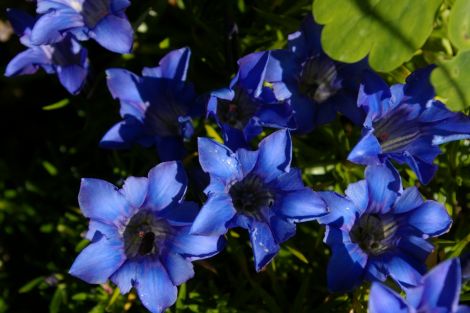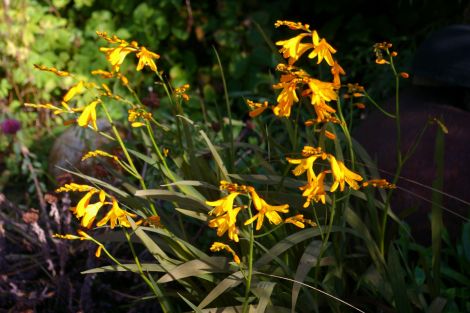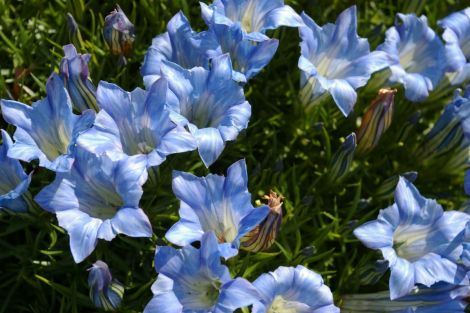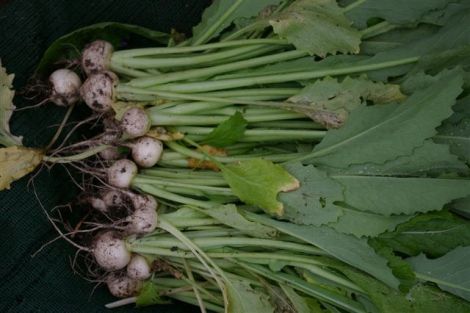Four Seasons / Four Seasons – Early Autumn
Gossip and rumour, I’m told, oil the wheels of social interaction in small (island) communities. Gossip, as it breaks free from its roots in reality and takes on a life of its own, also ruins reputations, as I know to my cost. There are of course some reputations that deserve to be ruined for the common good, and I shall ruin one forthwith.
I’m not sure where or how those vicious rumours started, but I’ve just learned that Chinese autumn gentians are “extremely difficult to cultivate and for specialist growers only”. Nothing could be further from the truth. Gentiana sino-ornata, along with its numerous cultivars, is one of the few plants that not only puts up with damp, peaty soil, but actually revels in it.
Provided you’re not gardening on limestone, it is indeed one of the easiest of alpines to grow and propagate. It is also one of the most beautiful alpines I know, and I know – at long last – why all those pots of autumn gentians kept sitting on the shelf in my nursery (see to “my cost” above).
Now it’s time to bring some psychology into play, using my own, past experience regarding “difficult” plants. I used to buy a lot of plants by mail order, and still do so to some extent. On arrival the “easy” ones were put straight into the garden, while the “difficult” ones remained in their pots, were sheltered from wind and rain in cold frames, or even the greenhouse. Most of the “difficult” ones died – proof that they were indeed “difficult” – while the “easy” ones thrived and multiplied.
These outcomes, as I learned later, had nothing to do with the plants themselves, but my attitude towards them. Plants need their freedom, they want to get their roots into the soil rather than have them confined in a pot, they want to be rained on and have the wind blow through their leaves. Alpines especially need a cool, airy location to thrive and abhor high temperatures under glass.
Become a member of Shetland News
Once I started planting everything as soon after arrival as the weather allowed, my losses dwindled to nothing. It’s the fear of doing something wrong which leads to doing nothing, and kills plants more often than not.
Another complaint filed against the wonderful gentian, is that it flowers too late. What is too late I wonder? The flowering of colchicums, kniphofias, and crocosmias, to name but a few autumn performers, coincides with that of the gentians, yet they are rarely, if ever accused of not arriving on time – a clear case of double standards.
Gentiana sino-ornata opens its first buds in mid September and, divided into small sections in spring, will soon form a pool of deep vivid blue. If you want an early cultivar, try Gentiana ‘Strathmore’ which has flowers of a lighter shade, and starts its season in August.
But now its time to ruin a reputation – hopefully for good. The humble turnip, neglected by celebrity chefs for decades, has recently been elevated to gourmet fare. Gardeners have of course valued this vegetable for centuries, and don’t give a toss about culinary fashions.
Turnip ‘Tiny Pal’ seems to be the neep (not to be confused with swede) of choice at present; its praises have been sung up and down the country, by cooks and seed companies alike. Pulled when the size of a golf ball, it is said to provide an endless supply of meltingly tender roots from successive sowings.
I did indeed get one pulling of said golf balls – before the rest of the crop rapidly ran to seed. Exactly the same happened with the second, and third sowing – with one important difference – the plants all bolted while their white, swollen roots were the size of marbles.
Unless you plan to win first prize for a basket of mixed vegetables at your local show, there is, to my mind, little reason to grow more than one turnip cultivar. After trying countless ones with mixed results during the past thirty years, I found, about half a decade ago, the holy grail of turnip: T. ‘Atlantic’ is a purple-topped cultivar that needs no thinning (a heaven-sent for the busy gardener) and tastes equally good eaten raw or cooked – at any size. The young greens cook like spinach and – most importantly – it never bolts, regardless of the vagaries of our Shetland summers.
You may well ask why I grew the worse than useless ‘Tiny Pal’ this year? It was sent instead of ‘Atlantic’ with the following note: “Turnip Tiny Pal has superceded Turnip Atlantic.” Now if that isn’t adding insult to injury…
Damp, cool summers always bring their problems but, surprisingly, the dreaded and – given the weather – expected, tattie blight wasn’t one of them. The shores of our main crop potatoes, ‘Lady Balfour’ and ‘Pink Fir Apple’ have been the strongest and healthiest I can remember and we harvested a bumper crop from a dozen ‘Duke of York’ tubers, or so we thought until our neighbour Jimmy, treated to a meal of home produce the other night, told us the tubers were the wrong shape, and probably ‘Sharpe’s Express’. Jimmy knows his tatties.
What bliss to get a few days of Indian summer, great for a final blitz on bittercress and groundsel, and for planting while the soil is warm. The longer I garden, the more I tend towards autumn planting, which brings many advantages. We never get those long spells of drying easterly winds that desiccate tender young leaves and there is always enough rain or dew to speed the settling in of new arrivals.
Trying out new plants is one of the great joys of gardening, but please don’t tell me you’ve tried a new and highly fashionable turnip and feasted on meltingly-tender golf balls all summer.
Rosa Steppanova (www.leagardens.co.uk)
Become a member of Shetland News
Shetland News is asking its many readers to consider paying for membership to get additional features and services: -
- Remove non-local ads;
- Bookmark posts to read later;
- Exclusive curated weekly newsletter;
- Hide membership messages;
- Comments open for discussion.
If you appreciate what we do and feel strongly about impartial local journalism, then please become a member of Shetland News by either making a single payment, or setting up a monthly, quarterly or yearly subscription.






























































